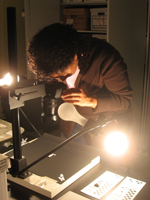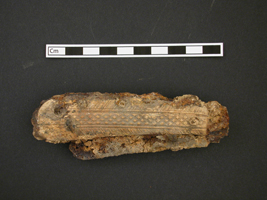Hi! My name is Madeleine “Bear” Douglas, and I am a second-year undergraduate student here at Stanford University double majoring in Archaeology and Economics. I decided to take this class because although I am an archaeology major, until now I had no practical experience with analyzing a collection. I thought I could learn a lot from a lab class in preparation for my studies later on and for this summer, when I will be on a dig in Çatalhöyük, Turkey. It has been a privilege to work with the materials from the San José Market Street Collection, and I hope that my project, on oral hygiene and toothbrush technology in the Market Street Chinatown, will be of interest and maybe of use to some of you.
Now that the quarter is coming to an end, everyone in the class is logging extra hours in the lab, pulling out and cataloging artifacts relevant to their projects, taking measurements, and checking historical references. As part of our projects, each of us will be making a presentation to the class on our research and our findings. To help us make more effective presentations, and also to teach us an important part of data management in archaeology, this week we learned about archaeological photography. Our guest lecturer, Jason Quinlan, taught us all a great deal about what goes into taking a good artifact photograph. First, you have to choose what aspect of the artifact you want to come through in the photograph: what is interesting or special about it? For example, if you want to emphasize the texture on an object, or some sort of engraving on its surface, using oblique lighting to cast a slight shadow will help that texture come out. If the object is smooth, you may not want to create those shadows. One of the most important things about archaeological photographs is scale. In every photograph, it is important to include a scale (a piece of paper or wood with length markings) in order to show the artifact’s size. Otherwise, it would be easy to think a huge urn could fit in the palm of your hand! We experimented in lab with photographing some of our artifacts, altering the aperture and shutter speed on the cameras to see the different effects of the change in lighting. This week’s artifact of the week served as our guinea pig- you can see the result below.
Featured Artifact
I found this week’s featured artifact bagged up in a box with some other small bone finds while I was searching for toothbrushes to analyze for my project. It is an ivory handled jackknife about 10 cm long with a blade that corroded while partially unfolded. The handle is engraved on both sides with a raised diamond pattern in the center and crosswise marks on the side. I was struck by the quality of the craftsmanship on the handle and by how well preserved it was. A knife like this would have been very expensive, and was probably a prized possession of the person who lost it.


